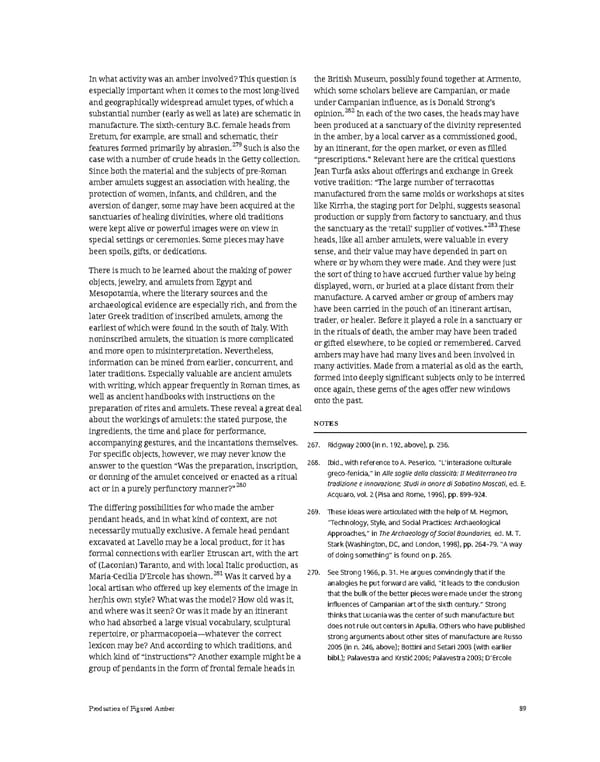In what activity was an amber involved? This question is the British Museum, possibly found together at Armento, especially important when it comes to the most long-lived which some scholars believe are Campanian, or made and geographically widespread amulet types, of which a under Campanian influence, as is Donald Strong’s substantial number (early as well as late) are schematic in opinion.282 In each of the two cases, the heads may have manufacture. The sixth-century B.C. female heads from been produced at a sanctuary of the divinity represented Eretum, for example, are small and schematic, their in the amber, by a local carver as a commissioned good, features formed primarily by abrasion.279 Such is also the by an itinerant, for the open market, or even as filled case with a number of crude heads in the Getty collection. “prescriptions.” Relevant here are the critical questions Since both the material and the subjects of pre-Roman Jean Turfa asks about offerings and exchange in Greek amber amulets suggest an association with healing, the votive tradition: “The large number of terracottas protection of women, infants, and children, and the manufactured from the same molds or workshops at sites aversion of danger, some may have been acquired at the like Kirrha, the staging port for Delphi, suggests seasonal sanctuaries of healing divinities, where old traditions production or supply from factory to sanctuary, and thus were kept alive or powerful images were on view in the sanctuary as the ‘retail’ supplier of votives.”283 These special settings or ceremonies. Some pieces may have heads, like all amber amulets, were valuable in every been spoils, gifts, or dedications. sense, and their value may have depended in part on where or by whom they were made. And they were just There is much to be learned about the making of power the sort of thing to have accrued further value by being objects, jewelry, and amulets from Egypt and displayed, worn, or buried at a place distant from their Mesopotamia, where the literary sources and the manufacture. A carved amber or group of ambers may archaeological evidence are especially rich, and from the have been carried in the pouch of an itinerant artisan, later Greek tradition of inscribed amulets, among the trader, or healer. Before it played a role in a sanctuary or earliest of which were found in the south of Italy. With in the rituals of death, the amber may have been traded noninscribed amulets, the situation is more complicated or gifted elsewhere, to be copied or remembered. Carved and more open to misinterpretation. Nevertheless, ambers may have had many lives and been involved in information can be mined from earlier, concurrent, and many activities. Made from a material as old as the earth, later traditions. Especially valuable are ancient amulets formed into deeply significant subjects only to be interred with writing, which appear frequently in Roman times, as once again, these gems of the ages offer new windows well as ancient handbooks with instructions on the onto the past. preparation of rites and amulets. These reveal a great deal about the workings of amulets: the stated purpose, the NOTES ingredients, the time and place for performance, accompanying gestures, and the incantations themselves. 267. Ridgway 2000 (in n. 192, above), p. 236. For specific objects, however, we may never know the answer to the question “Was the preparation, inscription, 268. Ibid., with reference to A. Peserico, “L’interazione culturale or donning of the amulet conceived or enacted as a ritual greco-fenicia,” in Alle soglie della classicità: Il Mediterraneo tra act or in a purely perfunctory manner?”280 tradizione e innovazione; Studi in onore di Sabatino Moscati, ed. E. Acquaro, vol. 2 (Pisa and Rome, 1996), pp. 899–924. The differing possibilities for who made the amber 269. These ideas were articulated with the help of M. Hegmon, pendant heads, and in what kind of context, are not “Technology, Style, and Social Practices: Archaeological necessarily mutually exclusive. A female head pendant Approaches,” in The Archaeology of Social Boundaries, ed. M. T. excavated at Lavello may be a local product, for it has Stark (Washington, DC, and London, 1998), pp. 264–79. “A way formal connections with earlier Etruscan art, with the art of doing something” is found on p. 265. of (Laconian) Taranto, and with local Italic production, as Maria-Cecilia D’Ercole has shown.281 Was it carved by a 270. SeeStrong 1966, p. 31. He argues convincingly that if the local artisan who offered up key elements of the image in analogies he put forward are valid, “it leads to the conclusion her/his own style? What was the model? How old was it, that the bulk of the better pieces were made under the strong and where was it seen? Or was it made by an itinerant influences of Campanian art of the sixth century.” Strong who had absorbed a large visual vocabulary, sculptural thinks that Lucania was the center of such manufacture but does not rule out centers in Apulia. Others who have published repertoire, or pharmacopoeia—whatever the correct strong arguments about other sites of manufacture are Russo lexicon may be? And according to which traditions, and 2005 (in n. 246, above); Bottini and Setari 2003 (with earlier which kind of “instructions”? Another example might be a bibl.); Palavestra and Krstić 2006; Palavestra 2003; D’Ercole group of pendants in the form of frontal female heads in Production of Figured Amber 89
 Ancient Carved Ambers in the J. Paul Getty Museum Page 98 Page 100
Ancient Carved Ambers in the J. Paul Getty Museum Page 98 Page 100